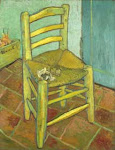With the New Year come new shows. This list is in no way intended to be comprehensive, but here are some upcoming museum exhibitions that strike my fancy:
*Art Institute of Chicago: "Becoming Edvard Munch: Influence, Anxiety and Myth" (Feb 14th-April 26th). This major show will include ca. 75 paintings and 75 works on paper by Munch and his peers (including, apparently, something by van Gogh although the AIC website does not say what). The exhibition is meant to challenge the popular-culture view of Munch as emotionally unstable. Munch made the news recently when his "Vampire" sold for over $38 million at Sotheby's NY November auction. N.B. the AIC's new Impressionist and Post Impressionist galleries open December 16th.
*Baltimore Museum of Art: "A Circus Family: Picasso to Léger" (Feb 22nd-May 17th). This exhibition showcases images of the circus and circus performers in the early 20th century, but begins with the late 19th century and posters by Toulouse-Lautrec. Picasso's sympathetic saltimbanque images form the core of the show.
*British Museum, London: "Babylon: Myth and Reality" continues until March 15th. Considering that ancient Babylon lies smack in the middle of modern conflict in Iraq, this show is both timely and important.
*Getty Center, Los Angeles: "Captured Emotions: Baroque Painting in Bologna, 1575-1725" (Dec 16th-May 3rd). This show focuses primarily on the famed Carracci family of painters, but also includes work by other Bolognese notables such as Guido Reni and Guercino. Bologna is one of my favorite European cities, can I just say -- amazingly under-touristed but filled with good things to see (and eat).
*Musée d'Orsay, Paris: "See Italy and Die" (I love the title), from April 7th to July 19th. An exhibition of 19th-century "Grand Tour" photography which promises to be a treat.
*Museum of FIne Arts, Boston: "Titian, Tintoretto, Veronese: Rivals in Renaissance Venice" (March 15th-August 16th). This one is co-organized by the MFA and the Louvre, and will feature sixty paintings from European and American collections. I love Tintoretto -- this looks like a great show.
*National Gallery of Art, Washington DC: "Pompeii and the Roman Villa" will be on view until March 22nd. A student of mine saw this one over Thanksgiving and said it was terrific. Running from 1 February until 3 May will be "Pride of Place: Dutch Cityscapes of the Golden Age," co-organized with the Mauritshuis in The Hague and intended to celebrate the 400th anniversary of Dutch exploration in the Hudson River Valley. Jacob van Ruisdael's famous view of Haarlem and the bleaching fields will be featured (I teach that painting in survey and was happy to see it in person in The Hague last year).
*Philadelphia Museum of Art: "Cézanne and Beyond" (Feb 26th-May 17th). Includes forty paintings and drawings by Cézanne, plus numerous works by other artists to show his context and influence.
*Royal Museums of Fine Arts of Belgium, Brussels: "Alfred Stevens" (May 8th - 23rd August). This Belgian painter is less-known now, but in his day, he was hugely successful. He lived much of his career in Paris and was close friends with Edouard Manet, among others. One of his models (and his possible lover for a while) was none other than Victorine Meurent, the model for Manet's "Olympia."
And on the van Gogh front...
*Kunstmuseum Basel: "Vincent van Gogh Between Earth and Heaven: The Landscapes" (April 26th-Sept 27th). Ohhh I am sorry to be missing this one!
*Van Gogh Museum, Amsterdam: "Van Gogh and the Colors of the Night," the European showing of the exhibition currently in New York, from 13 February through 7 June. The VGM has posted their entire exhibition calendar for 2009, which includes "Van Gogh's Letters: The Artist Speaks" from 9 October through 3 January 2010. The letters show is HUGE because it coincides with the VGM's release of THE definitive new edition of Vincent's letters and the launch of a special website dedicated to the correspondence. Be still my beating heart!








